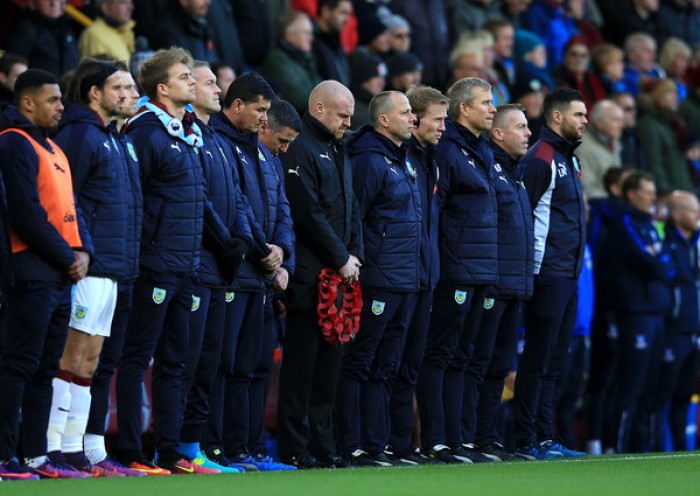Burnley scored a late winner for the second consecutive home game to secure a dramatic 3-2 victory over Crystal Palace to lift them into the top half of the Premier League table.
Ashley Barnes came off the bench to clinch an enthralling encounter, which had seen the Clarets surrender a two-nil lead in the second half as Palace battled back, only for Barnes to crash home a late strike to send the visitors back to London empty-handed.
It was a victory built on Sean Dyche’s successful recipe of endeavour, perseverance and flashes of quality, plus a sprinkling of luck – Andros Townsend saw a late opportunity for a second equaliser strike the base of the post.
But Burnley supporters were left elated with the kind of performance that bodes well for the rest of the season, as they bid to become an established Premier League outfit.
Dyche’s tactical switch drew credence
Following their hard-earned point against Manchester United the previous weekend, in which Burnley had lined up in a 4-4-2 formation, Dyche reverted back to the 4-2-3-1 system which had served him well in the enforced absence of striker Andre Gray.
The Burnley boss had said that lining up in the 4-4-2 formation at Old Trafford meant his team had nothing to lose, and Dyche also admitted he favoured having two strikers on the pitch.
So when it was announced that the Clarets would be entrusting Sam Vokes with the lone striker role, eyebrows were raised. Gray’s omission meant an immediate return to the starting XI for Steven Defour, who nestled back into midfield alongside the evergreen Dean Marney, with Jeff Hendrick deployed as a central attacking midfielder to support Vokes.
It meant Burnley could snuff out the influence of Palace midfielder Yohan Cabaye, whose range of passing to the likes of Townsend and Wilfried Zaha on the flanks is dangerous. Indeed, the Frenchman completed just 11 of his 17 attempted passes in the attacking third of the pitch.
The decision to leave Gray out also mean Hendrick could drop back into midfield and split Marney and Defour, who could provide auxiliary cover to the full-backs when faced with Townsend and Zaha: four of Marney’s five attempted tackles came down the right wing, while Defour’s three challenges down the left proved invaluable in aiding young Jon Flanagan against Zaha.
A mention for you, Ben Mee
Michael Keane’s performances have rightly earned many plaudits this season, but his increasing status overshadows the work of his defensive cohort.
Ben Mee was exceptional against the Eagles, and under the watchful gaze of England’s interim manager Gareth Southgate – who was present at Turf Moor – put in assured showing against the physical Christian Benteke.
The former Manchester City defender may have only won one aerial duel against the Belgian striker all afternoon, but Mee averted most of the danger from Palace’s set-pieces, making 24 clearances in total.
The defender uses his acute sense of positioning to thwart attacks before they can develop. Mee made two interceptions – one in the centre circle, and one within five yards of it – while three of his four attempted tackles came outside the area. All but one of his ball recoveries also occurred beyond the box.
The standard of his performances may surprise the national media, but those who follow the club closely acknowledge the importance of Mee’s presence in defence. He won the club’s Player of the Year award in their title-winning season in the Championship, and has taken the step back into the Premier League in his stride. If his form can be sustained, England may beckon.
Wingers offer the right balance
Dyche opted for Johann Berg Gudmundsson and Scott Arfield on the wings, and gave the team balance. Where there was Gudmundsson’s craft, there was Arfield’s graft.
The former enjoyed his best display in a Burnley shirt since his summer move from Charlton Athletic, with his first-half strike followed by his composed assist for Barnes’ winner. The Icelandic midfielder can lurk on the periphery of matches away from home, but at Turf Moor, he has the capacity to dazzle.
Gudmundsson received the ball 26 times, the second-highest amount for a Burnley player – only Vokes received more, but that accounts for goal-kicks and direct balls from defence. Gudmundsson also created the joint-most amount of chances for a teammate with two, and both led to goals.
Arfield, meanwhile, was an inspired choice ahead of Flanagan on the left flank. While the Canada international was relatively subdued offensively – and even then, he had highest pass completion rate of balls in the attacking third - he provided cover for the man behind him against the tricky Zaha. Unsurprisingly, his two tackles came down that same wing.
The industrious midfielder helped Flanagan develop into the game, who understandably looked shaky early on, but the Liverpool loanee soon settled. Having the assured head of Arfield alongside him would have helped erase those early jitters.










































